
Plant Type and Varieties

What type of plant is a bottlebrush?
Bottlebrush belongs to the genus Callistemon and encompasses a diverse range of shrubs and trees originating from Australia. With over 40 species and an array of cultivars, there’s a bottlebrush variety for every garden.
Notable choices include the vibrant Callistemon citrinus (Crimson Bottle Brush), the graceful Callistemon viminalis (Weeping Bottle Brush), and the elegant Callistemon salignus (White Bottle Brush). Some popular cultivars include ‘Little John’, which has compact growth and bright red flowers, and ‘Captain Cook’, which has pink flowers and a more upright habit. These plants are native to Australia but have been cultivated in various parts of the world due to their unique and attractive blooms.
What Colors Are Bottlebrush Plants?
Bottlebrush plants come in a range of colors, with red, pink, and white being the most common. There are also some bottlebrush plants that bloom in shades of purple, orange, and yellow. These vibrant colors add a pop of color to any garden or landscape. The unique shape of the bottlebrush flowers, with their long, cylindrical clusters of stamens, makes them a standout feature in any garden. Whether used as a focal point or as a border plant, bottlebrush plants are sure to attract attention with their striking and diverse colors.

Understanding Growing Conditions
One of the remarkable features of bottlebrush plants is their adaptability to various soil types. Bottlebrush can thrive whether your soil is sandy, loamy, or anything in between. These hardy plants prefer well-draining soil, preventing waterlogged roots that can lead to issues like root rot.
Bottle Brush is also sun-loving, craving full sunlight to showcase its best performance. Plant it in a spot that receives at least 6 to 8 hours of direct sunlight daily. This ensures robust growth, prolific flowering, and an overall healthy appearance.
Size and Aesthetics: Adding Beauty to Your Garden
The size of your bottlebrush plant depends on the species and variety you choose. Generally, they range from 1 to 4 meters in height, but some taller species like Callistemon viminalis (Weeping Bottle Brush) can reach to 8-9 meters. What makes them truly captivating are their distinctive bottlebrush-shaped flowers. Available in an array of colors, including red, pink, and white, these flowers make Bottle Brush a visually appealing addition to any garden.
Meeting Sunlight Requirements
For beginners, understanding the sunlight needs of your bottlebrush plant is crucial. Ensure it receives the recommended 6 to 8 hours of direct sunlight each day. If your plant is not thriving, signs of insufficient light may include reduced flowering, leggy growth, and a generally lackluster appearance. If you notice these signs, consider moving the plant to a sunnier location if possible.
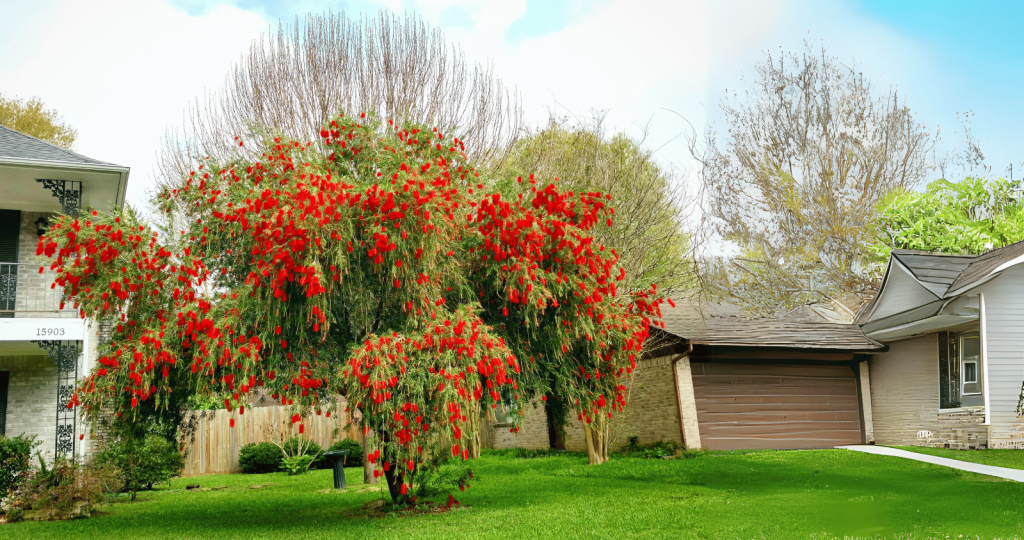
Are Bottlebrush (Callistemon) Drought-Tolerant?
Absolutely! Once established, bottlebrush plants are renowned for their drought tolerance. However, during prolonged dry spells, providing supplemental water is beneficial. This extra care ensures your bottlebrush remains vibrant and continues to produce those striking bottlebrush blooms as during dry spells you can often expect less flowers. If you still want to see considerate amounts of blooms, this product is great for helping with heat stress. This is best applied before the stress but can also help after or during a heat wave
Watering Needs: Keeping Your Bottle Brush Hydrated
While the bottlebrush is resilient, it does appreciate consistent watering. Aim for about 20-30mm of water per week, ensuring the soil remains consistently moist but not waterlogged. Adjust your watering frequency based on local weather conditions and the moisture retention of your soil.
Pruning Guidelines for Healthy Growth
Pruning bottlebrushes is very simple.
Annual prune to keep the plant healthy: The best time for pruning is after the flowering period, usually in late spring or early summer. Using clean, sharp pruning shears, remove spent blooms and shape the plant to encourage bushier growth. If you are looking for some really good shears, here are two great options depending on your budget: option 1 and option 2.
Regular pruning for informal hedges: Light hedge trimming can help keep your bottle brush neat and compact. Small hedges like “Little John” may need pruning every 4-8 weeks, whilst large informal screening hedges will do well with pruning every 10-14 weeks.
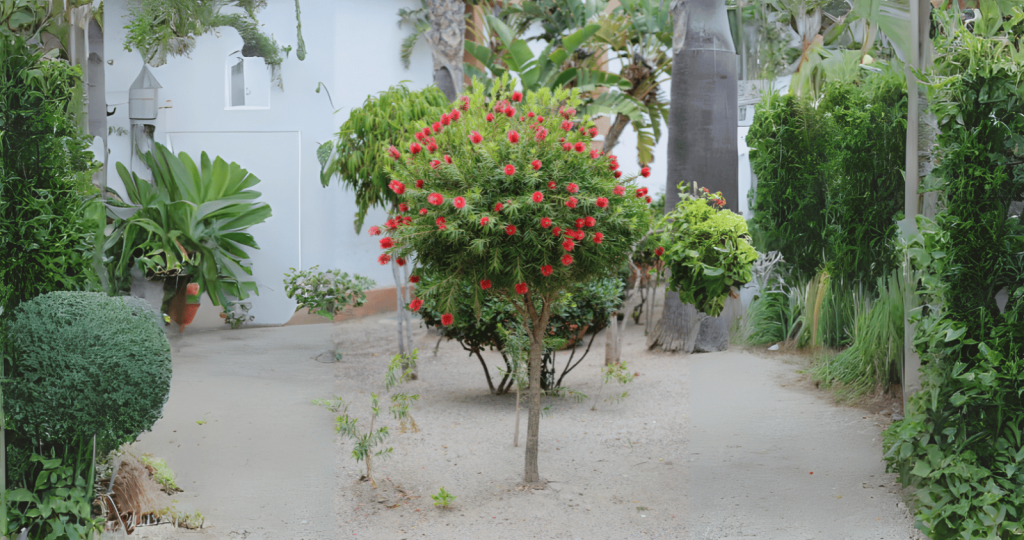
Growth, Lifespan, and Propagation
Understanding Growth Rates
It is hard to give exact growth rates as this depends on the variety and the conditions. On average, these plants can grow 0.5 to 1 meter per year, depending on the species and growing conditions. This rapid growth adds to their appeal, making them an excellent choice for gardeners looking to establish a vibrant landscape quickly.
What is the fastest-growing bottlebrush plant?
Among its species, one of the fastest-growing varieties is the Weeping Bottlebrush or Callistemon viminalis. This species can reach full height (6-9m) in just a few years, making it an ideal choice for those looking to quickly establish a natural barrier or create shade. However, its rapid growth can also pose a challenge in terms of maintenance. Regular pruning is necessary to prevent the tree from becoming too large and overwhelming the surrounding landscape. Additionally, the Weeping Bottle Brush may require extra care and attention to maintain its shape and prevent it from encroaching on nearby plants.

Soil Preferences and Improvement: Creating the Ideal Environment
Bottlebrush plants are adaptable, but they do have preferences. They thrive in well-draining, slightly acidic to neutral soil (to find out what your soil PH is use this kit). If your soil is sandy, enrich it with organic matter like compost to enhance water retention. (If you need a small amount of compost, this is a great option, if you need a larger quantity the best option is to contact your local soil supplier.) For clayey soil, improve drainage by incorporating sand and organic amendments.
Fertilisation: Nourishing Your Bottle Brush
While Bottle Brush can tolerate nutrient-poor soils, a bit of fertilisation can go a long way in promoting flowering and overall plant health. Use a balanced, slow-release fertiliser in spring, ensuring it’s low in nitrogen to prevent excessive foliage growth.
Should I feed my bottlebrush plant?
While bottlebrush plants can tolerate nutrient-poor soils, periodic feeding with a balanced, slow-release fertiliser in spring can promote healthier growth and flowering. Fertilising your bottlebrush plant can provide it with the necessary nutrients to thrive and produce vibrant flowers. It is important to choose a balanced, slow-release fertiliser that is low in nitrogen to prevent excessive foliage growth. By incorporating this feeding regimen into your spring gardening routine, you can encourage healthier growth and maximize the blooming potential of your bottlebrush plant.
What is the best fertilizer for bottlebrush trees?
A balanced, slow-release fertilizer with equal N-P-K (nitrogen, phosphorus, and potassium) content is suitable for bottlebrush trees. Avoiding excessive nitrogen is crucial, as it can divert the plant’s energy towards leaf production rather than flower formation, hindering its overall blooming potential. Therefore, a slow-release fertilizer with roughly equal amounts of nitrogen, phosphorus, and potassium is the best choice for bottlebrush trees. Here is a great organic balanced fertiliser that can be used on just about every plant
Common Pests and Diseases: Nipping Problems in the Bud
Bottlebrush plants are relatively hardy, but like any garden inhabitant, they can face challenges. Whilst very rare, some pests like scale insects and aphids may be seen on a bottlebrush. Combat these with insecticidal soap or neem oil (here is where you can find some neem oil). Root rot can occur in waterlogged soil, so proper drainage is crucial. Keep an eye out for rust and fungal leaf spots, treating them promptly with fungicides. (Here is an organic fungicide that will help with fungal leaf spots such as powdery milder and black spots.)
Common Mistakes: Learning from Experience
- Overwatering Woes: Ensure well-draining soil to prevent waterlogged roots and subsequent issues like root rot.
- Pruning Neglect: Regular pruning encourages bushier growth, enhances flowering, and maintains an attractive shape.
- Sunlight Shortage: Providing the recommended hours of direct sunlight ensures your Bottle Brush plant thrives and produces abundant blooms.
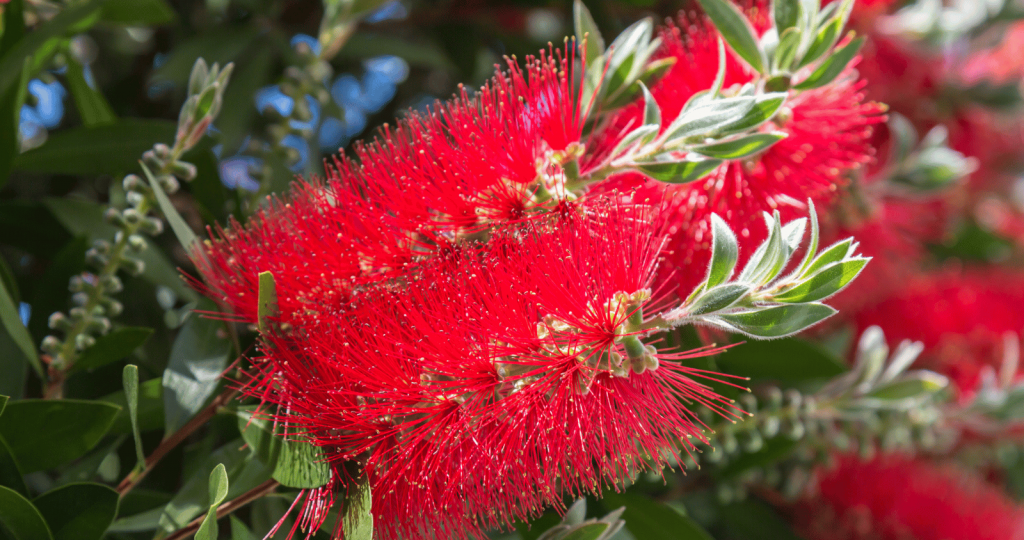
Unraveling the Secrets of Bottlebrush (Callistemon)
Common Names and Special Features
What is the lifespan of a bottlebrush tree?
Bottlebrush trees can have a lifespan of 20 to 40 years, depending on the species, growing conditions, and care provided. Factors such as climate, soil quality, and proper watering and fertilization can greatly impact the lifespan of a bottlebrush tree. With optimal conditions and proper care, some bottlebrush trees may live for up to 50 years. However, it’s important to note that as the tree ages, it may become more susceptible to diseases and pests, which can shorten its lifespan. Regular inspections and prompt treatment of any issues can help prolong the life of a bottlebrush tree.

How do you propagate a bottlebrush?
Bottlebrush plants can be propagated through seeds or cuttings. Seeds should be collected from mature capsules and sown in well-draining soil. Alternatively, cuttings can be taken from healthy branches and rooted in a suitable propagation medium. Both methods require patience and proper care to ensure successful propagation.
1. Propagating bottlebrush trees through seeds: This process requires careful harvesting and preparation of the seeds, as well as providing suitable growing conditions for germination. To propagate a bottlebrush tree through seeds, the seeds need to be collected from mature fruits and then soaked in water for 24 hours to loosen the hard seed coat. After that, the seeds can be planted in a well-draining potting mix and kept in a warm, humid environment until they germinate.
2. Cultivating bottlebrush trees from cuttings: Alternatively, bottlebrush trees can also be propagated through cuttings by taking a 6-8 inch long stem cutting from a healthy tree and removing the lower leaves. The cutting can then be dipped in a rooting hormone and planted in a potting mix, keeping it moist until roots develop. This technique involves selecting appropriate branch sections, preparing them for rooting and providing optimal conditions for successful establishment. (We recommend using this rooting hormone to help root formation in your cuttings.)
Maintenance and Common Issues
How do you maintain a bottle brush plant?
Maintenance involves regular watering, proper pruning after flowering, and periodic fertilization. Ensure they receive adequate sunlight and monitor for pests and diseases.
How do you reshape a bottle brush tree?
To reshape a bottlebrush tree, prune selectively after flowering. Remove any dead or crowded branches to encourage a more balanced and attractive shape.
Can I move my bottle brush plant?
While established plants may not appreciate transplanting, younger bottlebrush plants can be moved during their dormant season. Ensure you transplant with care, minimizing root disturbance.
Why is my bottle brush tree dying?
Several factors, such as overwatering, poor drainage, or pest infestations, could contribute to a dying bottlebrush tree. Evaluate environmental conditions, adjust watering practices, and inspect for pests to address the issue.
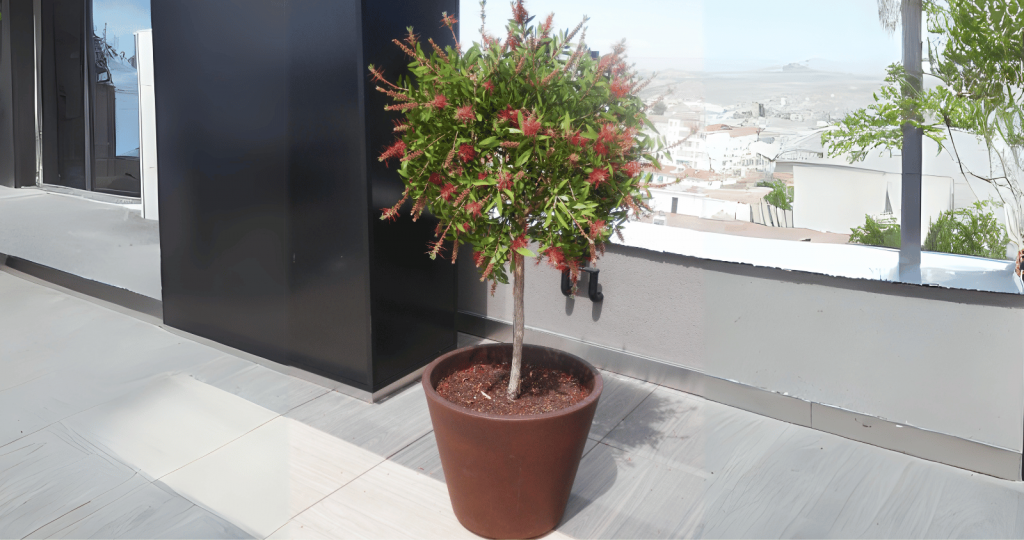
Leaves and Flowering
Do bottlebrush trees lose their leaves?
Bottlebrush trees are generally evergreen, retaining their leaves throughout the year. However, they may shed some leaves as part of their natural growth cycle.
Why is my bottle brush tree not flowering?
Insufficient sunlight, improper pruning, or nutrient deficiencies may hinder flowering. Ensure your plant receives enough sunlight, prune as recommended, and consider fertilizing with a balanced fertilizer.
How do you make a bottle brush flower?
Adequate sunlight, proper pruning, and occasional fertilization can encourage robust flowering. Ensure your plant is in a sunny location, prune after flowering, and provide a suitable fertilizer to enhance blooming.
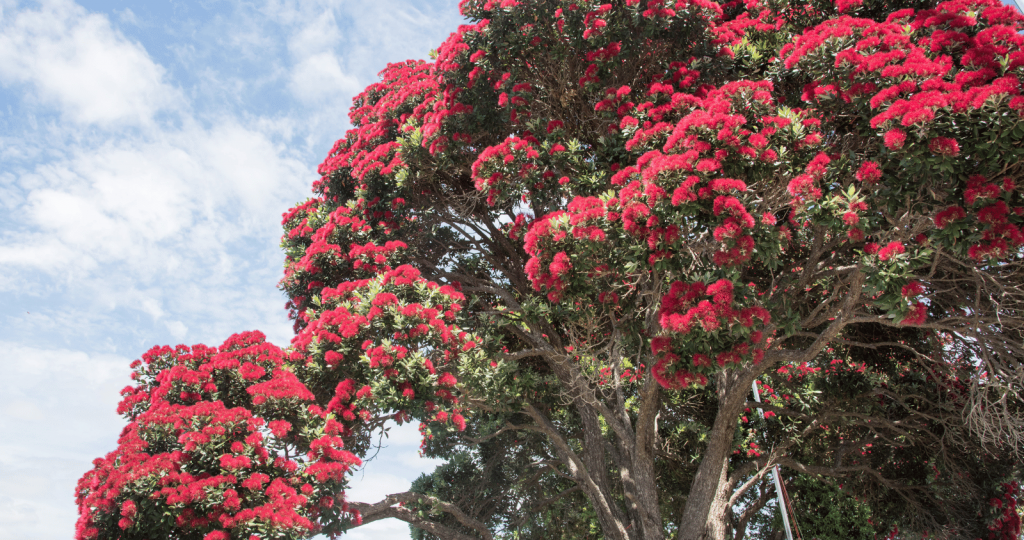
Interesting Facts and Benefits
What are some interesting facts about bottle brushes?
Bottlebrushes belong to the family Myrtaceae, which also includes eucalyptus trees. Some indigenous Australian cultures used the nectar from bottlebrush flowers as a sweet beverage. Bottlebrush trees are native to Australia and are known for their unique, brush-like flowers that resemble a bottle brush. These trees are also popular among birds and butterflies, as they provide a good source of nectar. Additionally, bottlebrush trees are known for their ability to attract beneficial insects, such as bees and hummingbirds, which can help with pollination in the garden.
What are the benefits of the Callistemon tree?
Callistemon trees offer not only aesthetic appeal but also attract pollinators like bees and birds. Their hardiness and adaptability make them low-maintenance additions to gardens. Furthermore, bottlebrush trees have the ability to thrive in various soil types and tolerate drought conditions, making them suitable for different climates. The dense foliage of these trees also provides shade, reducing the temperature and creating a more comfortable environment in the garden. Moreover, Callistemon trees have been used in traditional medicine for their antimicrobial and anti-inflammatory properties.
Is the bottlebrush plant anti-mosquito?
While not a guaranteed deterrent, some gardeners believe that the aromatic foliage of bottlebrush plants may help repel mosquitoes. However, it is important to note that we should not solely rely on it, as it is not a guaranteed deterrent for mosquitoes. Implementing proper mosquito control methods, such as removing standing water and using mosquito repellents, is essential for effective mosquito prevention.
What are the disadvantages of bottlebrush tree?
While bottlebrush trees are generally hardy, some disadvantages include their potential for becoming invasive in certain regions. Their rapid growth can lead to overcrowding, and some species may be sensitive to frost. Additionally, the bottlebrush tree’s dense foliage can create a lot of shade, which may hinder the growth of other plants in the vicinity. Furthermore, the tree’s flowers, although visually appealing, can produce a large amount of debris when they fall, requiring regular clean-up. Lastly, the bottlebrush tree’s shallow root system can make it susceptible to wind damage and instability during severe weather conditions.
